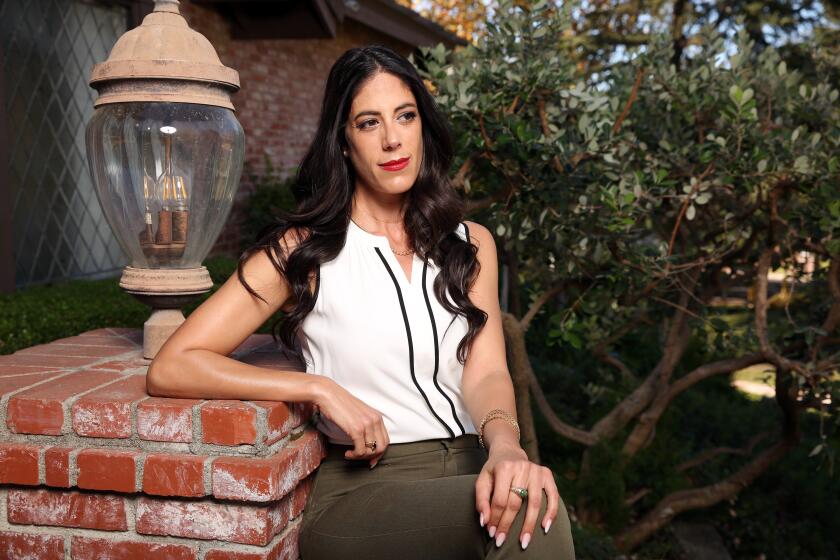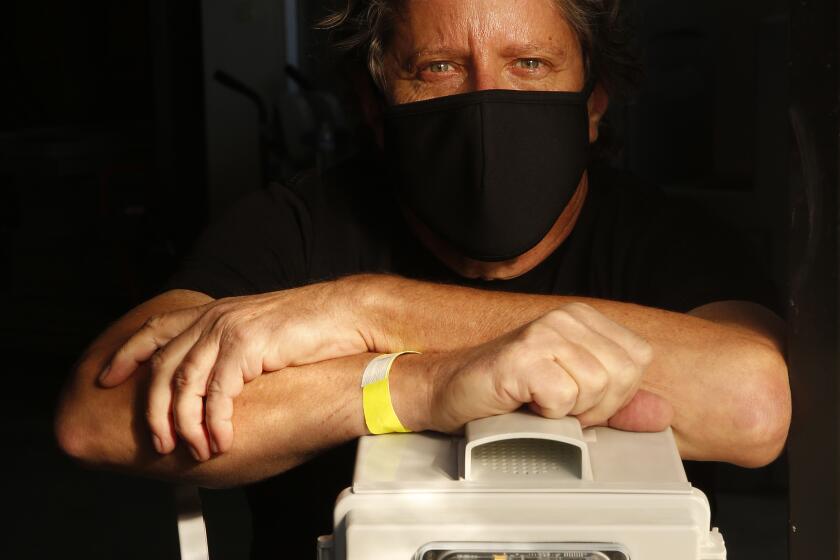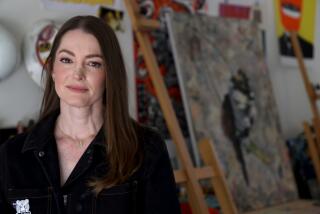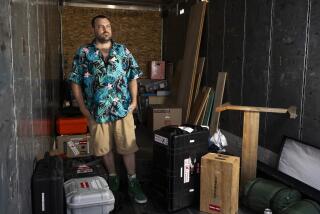How four independent production companies kept going during COVID-19
- Share via
After the COVID-19 pandemic forced Hollywood and the rest of the world to a standstill in mid-March, the entertainment industry is still seeking its return to normalcy.
Although California restarted issuing shooting permits in mid-June, filmmakers first had to adjust to a new normal that includes considerable new safety protocols and workflows that allow for as much socially distant filming and remote work as possible.
Initially, the productions allowed to go on were either short shoots with minimal crew, classified as essential (as in the case of educational film shoots), or commercial shoots, which had been exempt from many of the safety protocols required of bigger productions. (They’ve adopted more rigorous testing as cases surge.)
As filming came back, even large-scale productions, such as Warner Bros.’ “The Batman,” have faced challenges with positive cases on set. In September entertainment unions and major studios came to a consensus on new safety protocols and compensation rules for filming during the pandemic, including paid sick leave and quarantine pay.
On the independent side, smaller productions began implementing Centers for Disease Control and industry guidelines, as well as creating some new rules of their own.
While companies look ahead to 2021 with cautious optimism, here’s a breakdown of how four smaller-scale indie production houses adjusted to life in the age of COVID-19.
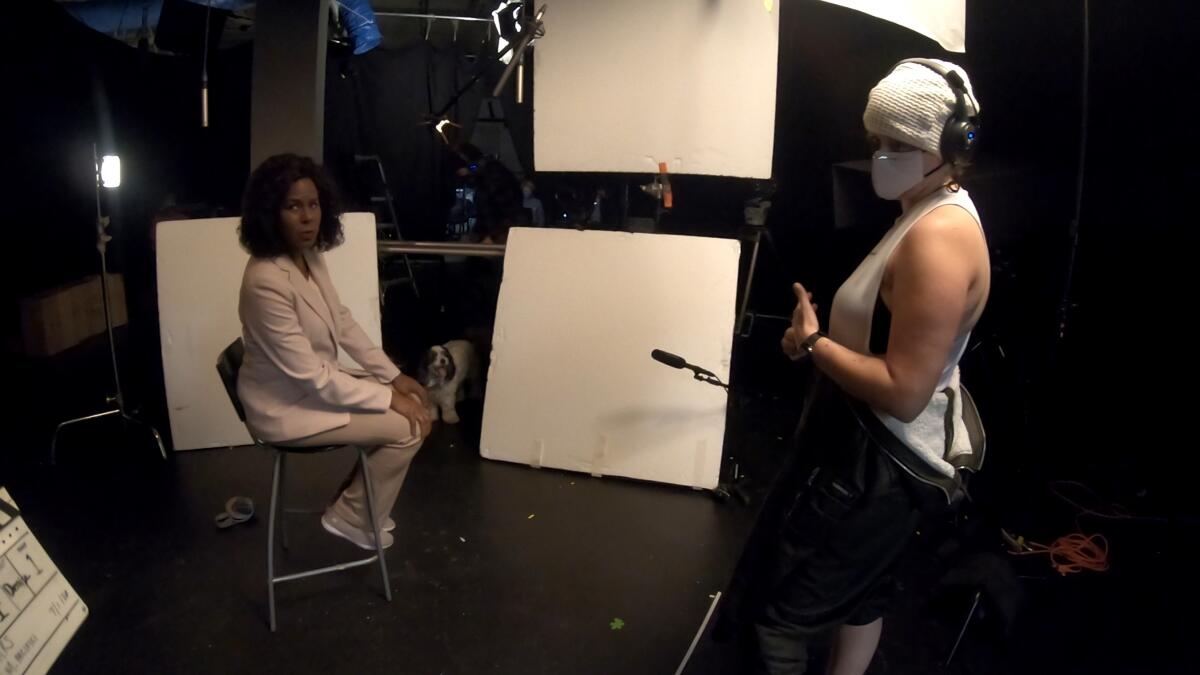
Genius Produced
Bona fides: Genius specializes in “binge-worthy education,” combining curriculum with storytelling for a product “that has the look and feel of something that you would watch on television,” says the company’s founder, K. Rocco Shields. “When students watch [our content] they’re not just getting told what they need to learn, they’re learning by experience.”
Based in: Los Angeles and Dallas
Staff size: 50
When the COVID-19 pandemic hit, Genius Produced had just completed filming a production cycle. “Some of our payment cycles got slowed because everyone was out,” said Shields. “But I was able to get a PPP loan and keep this train moving. And actually, [the pandemic] created even more of a need for our services.”
The company went remote for two months “until we absolutely had to come back for production,” said Shields. “And in that time I was able to pragmatically set procedures so that our building schematic was cleared out, unnecessary seating areas were removed, and there were access points to eliminate cross-contamination.”
Shields combined the safety regulations and mandates issued by the state, county, CDC and industry white papers with some of her own. “The first thing they mandated was that there had to be a COVID compliance officer,” she said. “Well, there was no training for COVID compliance officers. In fact, they didn’t exist at the time. So I searched and searched and found the first training and enlisted three of my employees.”
Because Genius Produced operates out of a 22,000-square-foot studio, “I have the luck of us being self-sustaining,” said Shields. “We have a full soundstage, so the first thing I did was section off the studio, creating touchless drop-off points and different color-coded zones that you could only access if you had on a specific color mask. Most of my postproduction became remote, and I was able to bring in minimal staff to put in separate air-conditioned offices. So postproduction became smaller, more remote and segmented from production. And I also knew we needed to test for COVID.”
Shields found that by streamlining the workflow, she actually increased productivity despite the rigorous new safety protocols. “Instead of hiring multiple crew members, I brought in seasoned pros that were able to fill multiple roles so that I had minimal crew on set,” she said.
“We shot with four cameras and I had four camerapeople that were also able to do lighting. We set up everything on remote-controlled dimmers and remote lights so that there was far less moving around. And all the cameras on the floor had remote follow focus and feeds and it got Zoomed and live cut directly to me as I sat in my little remote video village.
“We also all got on remote communication devices, kind of like they use for live [productions],” she added. “And we were able to set up shots without even getting within six feet of each other. The company purchased a variety of lavalier [mikes] and we asked the cast to mike themselves. And we created a ton of overhead booms that were on a remote pulley system so that we could move them around. It was really through the heavy use of technology that we were able to bridge the distance gap.”
The cast remained off set fully masked until it was time to come to set “and then all the crew cleared and the only people on set were the camera operators,” said Shields. “I also had a licensed, on-set cosmetologist in full mask, face shield and gloves who had labeled bags for each staff member, so there was no cross-contamination of anything on anyone. And all she did was light touch-ups.
“It’s incredible but we shot more this summer in eight- to 10-hour days [than we do normally],” Shields said. “In 25 days we shot 1,000 pages of scripted content and employed 100 SAG actors.”
As of November, the company has filmed “thousands” of videos with the help of an additional crew running out of Dallas.
“In battling obstacles, you start to find inefficiencies with your old processes and start to become better,” said Shields. “So since we’ve been doing it for so long now, we’re so much more efficient. We’re filming 70 pages a day doing it this way, whereas the industry standard is eight to 12.”
The next few months “is more of the same,” said Shields. “There’s obviously a need for online education and so we are busier than ever. We have a lot of vested clients and universities that want to transform their curriculum into something more than just a Zoom call. We’re not just filming talking heads, we are taking it and transforming it into storytelling. And we still COVID test multiple times a week, even our internal staff.”
While the COVID-19 pandemic has shrunk crew sizes and banned crowd scenes, Hollywood’s new safety rules mean longer jobs for some background actors.
Demo Duck
Bona fides: The company specializes in educational and corporate video projects including customer testimonials, commercials, video series, internal communications, branded content and social media videos.
Based in: Chicago
Staff size: 16
Demo Duck is one of the rare production houses that has become even more productive in the wake of the pandemic thanks to its newly remote workflow. “I think as a team it allows people to determine their day a bit more because they’re not [required] to be in the office by a certain time, so there’s a little bit of flexibility there,” said Colin Hogan, the company’s managing director.
When the staff does assemble on set, they have to submit to temperature checks and adhere to the social-distancing guidelines outlined by the CDC.
“We really try to set everything up completely before we bring any talent or any interview subjects onto set,” said Hogan. “And we try to decrease the length of our production days to not run people ragged and keep everyone’s immune system strong. We also have lunches eaten outdoors, have windows open for airflow and use single packaging for any snacks or drinks on set.”
The company, which produces between 150 and 250 videos a year, is on track to achieve the same this year. “We’ve probably kept our same amount of overall production pretty consistent,” said Hogan. “But nearly all of those videos, except for a small handful, will be animated videos or videos that can be done entirely on a computer. Luckily with our ability to do both live-action and animation, we pivoted some projects to animation and some to Zoom interviews and made those look as high-quality as possible.”
Rather than struggling logistically, Hogan said, the bigger challenge has been navigating the mental aspects of adjusting to life amid a global pandemic.
“If you’re filming something, [you have to consider] how long it is going to be acceptable for a piece of content to have people in masks or the Zoom style that’s become popular these days,” he said. “Do we want to make it more evergreen if the video is not tied to COVID-19 messaging or if we want it to last more than a couple of years? Is it going to feel out of date or a reminder of a tough 2020 for people viewing those videos in 2021? It remains to be seen.
“It’s hard not to have a little bit of weight on your shoulders at all times with the external forces,” he added. “So I think it’s less of the logistics and more of the mental pestering that has gotten more challenging. Making sure there’s ways to unplug and finding those mental breaks has become even more important since COVID.”
As the pandemic hit a second wave, “Our productions have remained safe but producing live-action videos has increased in complexity since the cases have risen,” said Hogan. “In September our state positivity was somewhere around 5%; now we’re closer to 13% and new restrictions have been put into place city- and statewide.”
Hogan has decided to pause all Chicago productions until January to assess how effective the safety protocols have been, “but also to give ourselves a mental break knowing that it’s a tricky road ahead with the holidays.”
“As we’ve increased our safety protocols, we have also increased the amount of preproduction necessary to make everything work smoothly,” he said. “I’m very proud of how safely we’ve produced videos in the past few months but we didn’t want to push our luck or overextend ourselves as we deal with a COVID surge locally. Especially with unknown government restrictions and mandates that could be handed down, operating in that uncertainty is tough when we need to plan for productions several weeks out.”
Because of the COVID-19 pandemic, new technologies are being developed to meet the needs of producers having to navigate stringent safety protocols for filming.
Indigo Productions
Bona fides: The full-service creative video production company specializes in commercials, virtual events, educational and corporate videos and entertainment projects.
Based in: New York
Staff size: Less than 10
Indigo Productions was in the middle of a full production schedule when the pandemic hit in March. “Everyone was panicking,” said Max Rosen, the company’s president. “We had already signed contracts to livestream graduations and do a whole bunch of different projects, and tons of stuff got canceled. But then people started to figure out how to do things safely and thankfully things came back to life. With a lot of changes, naturally.”
The production house, which rents studio space on a project-by-project basis, scrambled to adjust to the new normal, at times turning down clients and bringing in a medical supervisor for bigger shoots. “We didn’t want to put ourselves or our clients at risk, so we had to really educate ourselves as well as come up with technology,” said Rosen.
“We figured out safety protocols where we sent a one-man band in full gear to set up lighting, working slowly by himself and wearing a mask and booties. He’d set up the entire thing and then plug it in and feed it either on Zoom or Skype so our clients could monitor it remotely. We did all that while the talent was out of the room, and if we had to make any lighting adjustments, the talent would go out and the cameraman would go back in and tweak it until we got it just right.”
In instances where shooting would have been impossible or impractical, Rosen has gotten creative. “There’s been a lot of strategies,” he said. “Sometimes it’s taking existing content and reediting it with a new voice-over or new graphics. If it’s not possible to shoot something new, in certain cases we’ve done animated projects with motion graphics. In other cases, we’ve trained clients on how to self-film on an iPhone. We ship out little self-filming kits to clients that include lights and a little microphone and we can have a remote teleprompter set up through Zoom.
“We’ve been forced to be super creative and productive,” he added. “If we would normally send in a crew of five and can now only use a crew of two, then you’d better figure out how to be unbelievably efficient and productive.”
By the fall, “Business had really exploded, especially in the areas of virtual events and tours,” said Rosen. The company has created virtual events for clients like McGraw-Hill Education, NYU’s Alumni Association, the American Musical and Dramatic Academy and Brooklyn’s St. Joseph the Worker Catholic Academy.
The next few months are equally booked. “Many schools have already reached out to us, anticipating that all in-person gatherings will likely need to be virtual in 2021,” said Rosen. “We are extremely busy working with schools to plan for this.”
In the wake of the pandemic, the entertainment industry created a new position on set to help keep outbreaks at bay.
Covalent
Bona fides: Covalent is a video-focused creative production company specializing in “crafting unique stories to help clients better connect with their customers and audiences,” said cofounder Jeffrey Hilty. The company produces an array of content from brand and corporate videos to documentary and docu-style videos as well as animation and motion graphics.
Based in: Pittsburgh and Berlin
Staff size: 4
When the pandemic first hit, Hilty took the company’s offices remote. “We’ve given everyone the choice [to continue that way],” he said. “Especially editors that have machines set up at their houses at this point. We’re working fine as a remote entity.”
Because the company doesn’t have its own studio in which to produce its signature docu-style videos, “There was not really any shooting happening,” said Hilty. Since COVID, Covalent has shot only a few live-action content pieces. “Most clients don’t want to do it,” he said. “They’ve been looking for creative solutions around shooting. If I have to cut another stock-footage video, I’m going to lose my mind.”
When the staff does assemble for a shoot, Hilty has mandated temperature testing and cut down on crew sizes. “We’re really following all the local ordinances that were set down,” he said. “The world is very different, because you went from really no protocols to now you’re sanitizing and wearing masks and keeping distance and being mindful of all these things. I think it’s just caused us to slow down and become a bit more thoughtful.
“Since COVID, we’ve actually been shooting very minimally,” he added. “It’s been a lot more postproduction work and animation. We are trying to do remote shooting in a much more scaled-down way with webcams, different camera rigs and iPhones as monitors. If there is any shooting, we use crews that are about a third of the size and shoots are much slower. Everything’s much more methodical and careful.”
Currently, “Things are steady,” said Hilty. “It’s a little slower than normal for this type of year but I wouldn’t say that things have gotten any worse. The next few months are usually slow but we have a decent flow of post work that should help us through. It will be an interesting early 2021.”
More to Read
Only good movies
Get the Indie Focus newsletter, Mark Olsen's weekly guide to the world of cinema.
You may occasionally receive promotional content from the Los Angeles Times.
